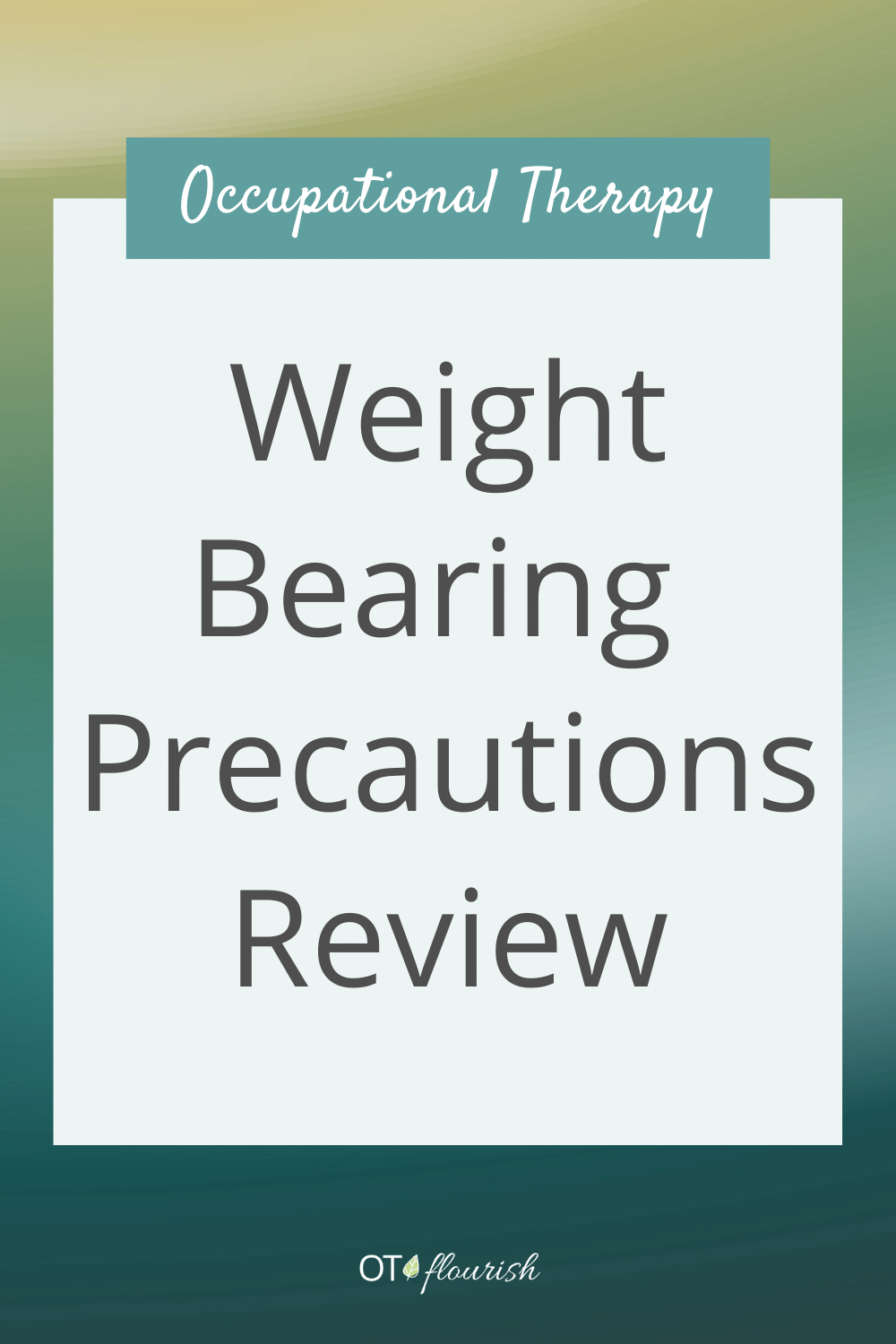Per usual practice, occupational therapy practitioners don’t typically set up or change weight bearing precautions for their patients. That order comes from their primary physicians who also order therapy evaluations and services to begin with. Occupational therapy practitioners (OTPs) are informed about weight-bearing precautions via a prescriptive order in the form of, sometimes unrecognizable, acronyms: TTWB, NWB, PWB, and WBAT to name a few.
Let’s further explain some of the acronyms, explore interpretations, and the review the application to OT intervention, especially if you are new to working in a setting such as acute care or skilled nursing.
First, Why Would a Patient Have Weight Bearing Precautions Ordered Anyway
If a patient comes for a therapy evaluation with weight-bearing precautions, it could be due to several reasons such as:
- injury to a limb or joint (i.e. fracture),
- post-surgical condition of a limb or joint,
- congenital or degenerative breakdown of bone (i.e. osteogenesis imperfecta, severe osteoporosis, etc.) or
- necrotic breakdown of a limb or joint (i.e. bone cancer).
It’s the doctor’s intent to keep all or a certain amount of weight off of a limb entirely or just a single joint to prevent further damage or injury commonly utilizing a walker or assistive device.
How Does This Change the Occupational Therapy Intervention?
Due to ethical concerns and basic common sense, OT practitioners cannot alter or ignore weight-bearing precautions during therapy.
It is our job to educate the patient with compensatory and safety awareness strategies to go about mobility and functional activities with the weight-bearing precautions in mind.
For example, if a patient recently had a total shoulder replacement, the doctor may ask the patient to non-weight bear on the surgical shoulder up to several weeks. This means teaching the patient one-handed task management until the weight bearing precautions are upgraded by the doctor.
What Are the Different Types Commonly Seen in Occupational Therapy Practice
Below, we’ve explained the 6 most common acronyms we may come across in treatment orders for our patients and a brief description of what each means:
NWB (Non-Weight-Bearing):
This means absolutely no weight-bearing through the specified joint(s). For leg injuries or surgical operations, this means keeping the foot of the operative extremity completely off of the ground during all walking and transfer tasks.
For the arm, this could vary. If the doctor suggests no weight-bearing through the shoulder, there are still tasks in which the patient can move their wrist or elbow. However, the patient cannot lean into or carry anything in that arm until approved by the doctor.
TTWB (Toe-Touch Weight-Bearing):
In toe touch weight bearing, the patient can place their toe on the ground for very subtle balance, but the majority of their weight needs to be distributed through their shoulders and arms via a walker or crutches. Some clinicians argue that toe-touch weight bearing precautions allow up to 20% of the body weight to be distributed through the affected joint or limb.
The definition of TTWB is poorly defined in the research literature, but as Rubin et. al discuss in the research article titled, Toe-Touch Weight Bearing: Myth or Reality, they describe TTWB as “none, with having the ability to touch the foot or toes to the floor without supporting weight from the affected limb. The pressure should be light enough to avoid crushing a potato crisp underfoot” and some research supports weight up to 20% to be utilized for balance only.
TDWB (Touch-Down Weight-Bearing):
Touch-down means that the patient can place the entire bottom of their foot on the ground. However, the majority of their weight should be going through their arms and shoulders via crutches or a walker.


PWB (Partial Weight-Bearing):
Although the percentage is determined between the doctor and the patient, partial weight-bearing usually means “up to” 50% of the patient’s body weight. It’s not an exact science, but more of a “guesstimation.”
For Example:
If a 150-lb female patient is only allowed to place up to 50% of her body weight through her operative hip, this means only about 75lbs of pressure. This can be measured by using a scale and crutches and practicing weight distribution with the patient (we had a really great discussion on this topic after reading the article, Effectiveness of Audio Feedback for Partial Weight-Bearing in and Outside the Hospital: A Randomized Controlled Trial in the OT Accelerator.
WBAT (Weight-Bearing as Tolerated):
The patient can put up to full weight through the affected limb or joint. This is a commonly issued precaution for patients who experience same day joint replacement surgeries for knees and hips. The patient is still fresh out of surgery and so pain and discomfort will determine how much weight they decide to place down.
FWB (Full Weight-Bearing):
The patient is allowed to put full weight through the affected limb or joint because their injury has fully healed.
In summary, defining weight bearing precautions and recommended percentages of body weight can be very subjective depending on the doctor. However, the given weight-bearing precautions give therapists a rough estimate to follow in order to keep the patient safe. If you have any questions about a particular patient, personally consult with the patient’s ordering primary physician for any clarification.
Please share any tips you have to help your patient’s stick to their weight bearing precautions!
References:
Total Hip Exercise Booklet: Restricted Weight-Bearing. (2007). Sunnybrook Holland Orthopaedic and Arthritic Centre. https://sunnybrook.ca/uploads/THR_Restricted.pdf Viewed on Mar. 16, 2020.
Mayo Clinic. Rheumatoid Arthritis Pain: Tips for protecting your joints. Retrieved February, 10, 2010, from http://www.mayoclinic.com/health/arthritis/AR00015. Viewed on Mar. 16, 2020.
Thompson, S.G., Phillip, R. D. & Roberts, A. (2018). How to orthopaedic surgeons and rehabilitation professionals interpret and assess “toe touch’ weight bearing and ‘partial’ weight bearing status in the rehabilitation setting? (2018). BMJ Open Sport Exerc Med. 2018; 4(1): e000326 doi: 10.1136/bmjsem-2017-000326







